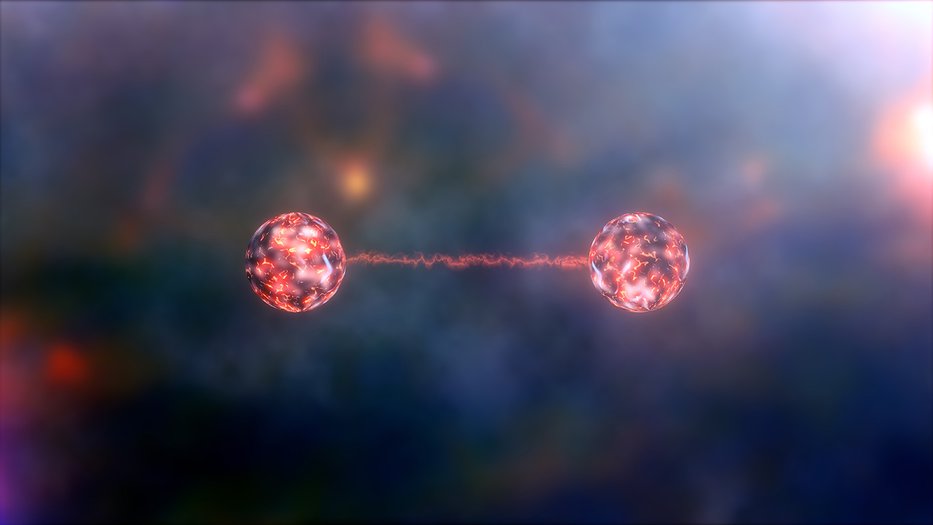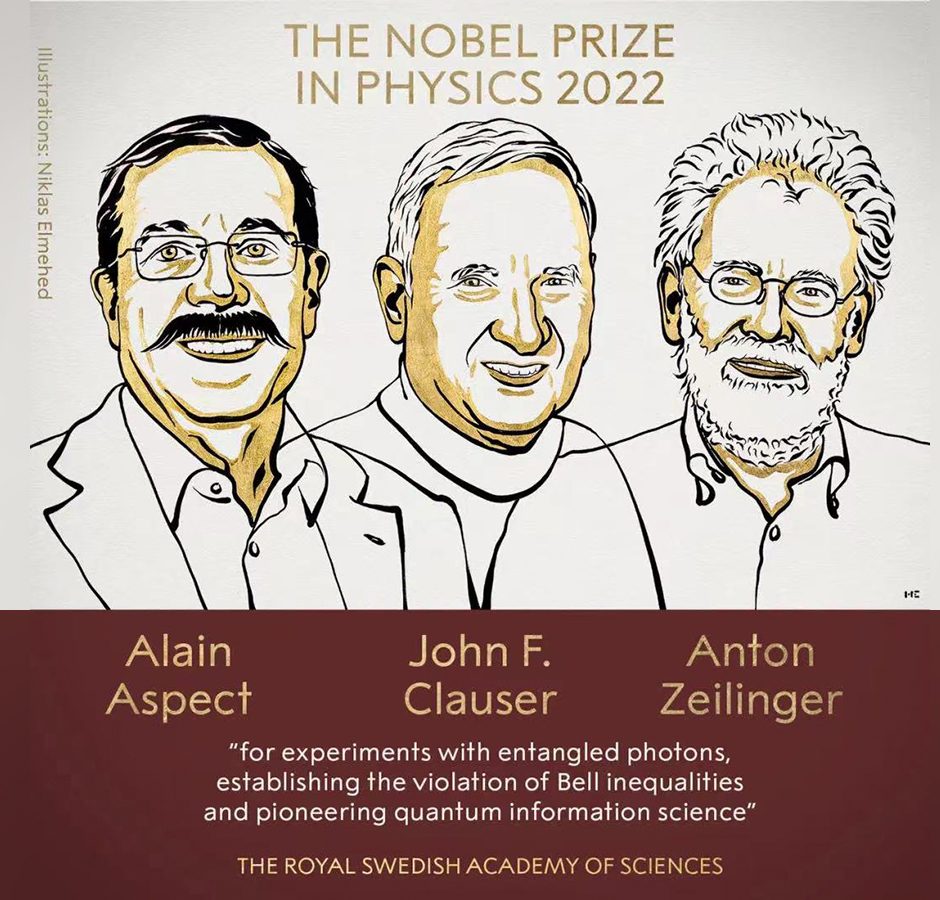In quantum mechanics, particles are described by their “quantum states”, mathematical objects that describe the probabilities of observing different results after measurements on them. Quantum entanglement is the effect where the individual quantum state of each particle in a certain pair is indefinite until measured, and the act of measuring one determines the result of the other, regardless of how far apart the particles are. Often in these experiments, the measured quantity is “spin”, a certain measure of angular momentum associated with a subatomic particle due to its behavior in magnetic fields. In fact, work involving Quantum entanglement provides the basis for this year’s Nobel prize in Physics.
The Nobel Prize in Physics 2022 was awarded jointly to Alain Aspect, John F. Clauser and Anton Zeilinger “for experiments with entangled photons, establishing the violation of Bell inequalities and pioneering quantum information science”.
EPR
In 1935, the physicists, Einstein, Podolsky, and Rosen (EPR) published an important paper (nicknamed “the EPR paper”) in which they claimed that quantum mechanics fails to provide a complete description of physical reality. They proposed that a more complete description would involve “hidden variables” that explain the workings in more detail. That is, though results in quantum mechanics are inherently probabilistic (they aren’t known in full certainty until measured), there must be hidden variables that govern those probabilities, making quantum mechanics ultimately deterministic (could be pre-determined, opposed to probabilistic).
An issue was that interactions should not be able to communicate instantly across large distances as the speed of light. Thus the maximum possible speed for transmitting information is finite. Then if this reasoning is applied to the case of measuring the spin of one entangled particle, instantly obtaining information on the spin of the other particle situated far away should not be possible. However, this was the experimental observation; entangled particles did communicate their spin states instantaneously between separate locations. This was the motivation for EPR to conclude that quantum mechanics is incomplete; that there must have been some extra hidden variables that set the responses of the entangled electrons to spin measurements at the beginning of the experiment when both electrons were generated at the same site.
Bell inequalities
In 1964, John Bell proved that the EPR conclusion; that there are hidden variables, implies that in some spin-correlation experiments, the measured quantum mechanical probabilities should satisfy certain inequalities called “Bell inequalities”. The correlation between spin states of entangled particles predicted by quantum mechanics is higher than what would be obtained if any hidden variables are involved. Later, experiments showed that the correlations are in fact higher than what is allowed by any hidden variable theory and the observations aligned with the results obtained from quantum mechanics. Hence the proposition by Einstein, Podolsky and Rosen was falsified. The Nobel Laureates were the experimenters who worked on key experiments conducted to investigate these phenomena.
The experiments
Nobel laureate John Clauser’s experiment involved an apparatus that emitted 2 entangled photons at a time, at filters that tested their polarizations; quantities related to spin. This showed a result that clearly violated a bell inequality and agreed with the predictions of quantum mechanics. However, there were some loopholes in these experiments that allow one to ask if the setup could have in some way specially selected for particles so that the result was obtained even though particles did actually carry hidden information.
Laureate Alain Aspect modified these experiments so that the detectors switched between different settings, hence the system could not contain any advance information that could affect the results. The results of these experiments confirmed that quantum mechanics is indeed right and that there are no hidden variables. Laureate Anton Zeilinger further refined the previous experiments on Bell inequalities and experimented on systems of more than 2 entangled particles, which were instrumental in the development of quantum information science.
Quantum Information Science
This emerging interdisciplinary field focuses on the analysis, processing and transmission of information using quantum mechanical principles, including the determination of what can and cannot be done using quantum information. The understanding of quantum states of systems forms the basis for quantum computation, transfer and storage of quantum information and algorithms for quantum encryption, hence the experiments described above are vital for this field.
Though quantum mechanics is many decades old, there is still much yet to be understood regarding its foundational aspects. The phenomena studied are counterintuitive and the mathematics are abstract, but quantum mechanics is very much utilized and in fact, essential in even standard technologies such as lasers, solar cells, and MRI scanners. More efforts in this endlessly exciting field will enable novel technologies and even more insights regarding the inner workings of the subatomic world.
See the following for more information on quantum entanglement and the Nobel prize;
- https://www.youtube.com/watch?v=tuyY2RlseBM&t=364s
- https://www.youtube.com/watch?v=0RiAxvb_qI4&t=981s
References:
- Popular information. NobelPrize.org. Nobel Prize Outreach AB 2022. Sun. 20 Nov 2022. https://www.nobelprize.org/prizes/physics/2022/popular-information/
- https://iep.utm.edu/wp-content/media/epr-bell-pdf-2018.pdf
- https://brilliant.org/wiki/quantum-entanglement/
Image Courtesies:
- Featured Image: http://bit.ly/3AuOswK
- Content Image 1: https://bit.ly/3VlnU9o
- Content Image 2: http://bit.ly/3AtTs4E



